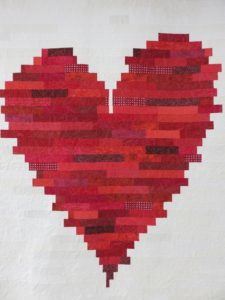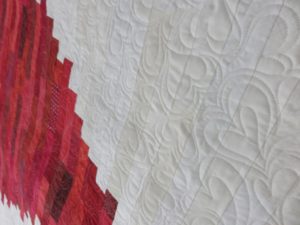
 |
| Quilt Pieced by Debra B. |
This was such a joy to quilt–check out the close up of the free motion hearts 🙂
 |

 |
| Quilt Pieced by Debra B. |
This was such a joy to quilt–check out the close up of the free motion hearts 🙂
 |
Ahhhhh! I’m dying a little bit over those Anna Maria Horner Pretty Potent prints. This is a fabric line that I adore, but never ended up making anything myself with. So it was a special treat to get to quilt this and ooh and ahhhh over the fabrics and quilt design.
When I first looked at this quilt, I was literally stumped at what to quilt it with. I knew it was going to be custom quilted, but couldn’t figure out what to do with all the negative space. I loaded it on the frame and it sat for a week. I sketched out ideas in my sketchbook and didn’t really have any great luck with inspiration. Finally I decided on a simple outlined design with some ruler work, embellished with pebbles and other straight lines to fill in the gaps.
You can see here a little better that each print fabric was outlined twice with a small ruler. Then pebbles were added, along with some straight lines for filler to add more texture.
In the midst of tragedy, I am relieved that I belong to a group of people that goes out of their way to show love for others. The group I’m talking about is the Modern Quilt Guild. And even more specifically, the San Antonio chapter of the Modern Quilt Guild. The Orlando MQG organized collections to accept in progress quilts and completed quilts to show support and love for some of the people affected by the Pulse night club shooting. I hate that I’m even writing a post about this, because it’s so disturbing the amount of violence we hear about on a daily basis on the news…but I want to focus on giving back and showing support for our fellow human beings.
The SAMQG members are SO giving and generous with their fabric and time, that we’ve had a plethora of blocks constructed (most using the Heart pattern tutorial by Cluck Cluck Sew). A few charity sew-ins, and we’ve finished (I think) 5 quilts!
I had the great opportunity to quilt a few of these, and wanted to discuss charity work in this industry. I’ve done a little bit of charity sewing in the past, but not really donated much of my time or resources prior to getting my longarm. And once I started donating my quilting, I kind of just rushed through the process, doing a stipple or some quick meandering design to get that top off my frame as quickly as I could. But one night, I started thinking about the recipients of these rushed through pieces I had worked on. Was I proud of the work I was doing on them? No. Absolutely not. I was just FINISHING THEM. There was nothing special or generous about what I was doing to add to the quilt. And maybe those recipients don’t even look at the quilting. But it really got to me that I was doing about 2% of my best work on something that was supposed to be making someone happier. I decided to start doing my best work on every quilt top. Whether it was a paying customer or not. If I’m going to commit to working on something, why would I give anything less than my best? And besides, if you want to look at it from a really selfish angle, it’s great practice and helps develop your skills even further.
I really love the graffiti quilting style, and chose to do that on this quilt. These blocks were pieced together by so many different people, with such love and compassion in their hearts. It really does give me a little bit of hope for humanity.
Anyway, my two cents for the day is to think about where your heart is when you decide to do charity work. If it’s in your heart, put your best foot forward and really give all you have. Otherwise, what are you wasting your time for?